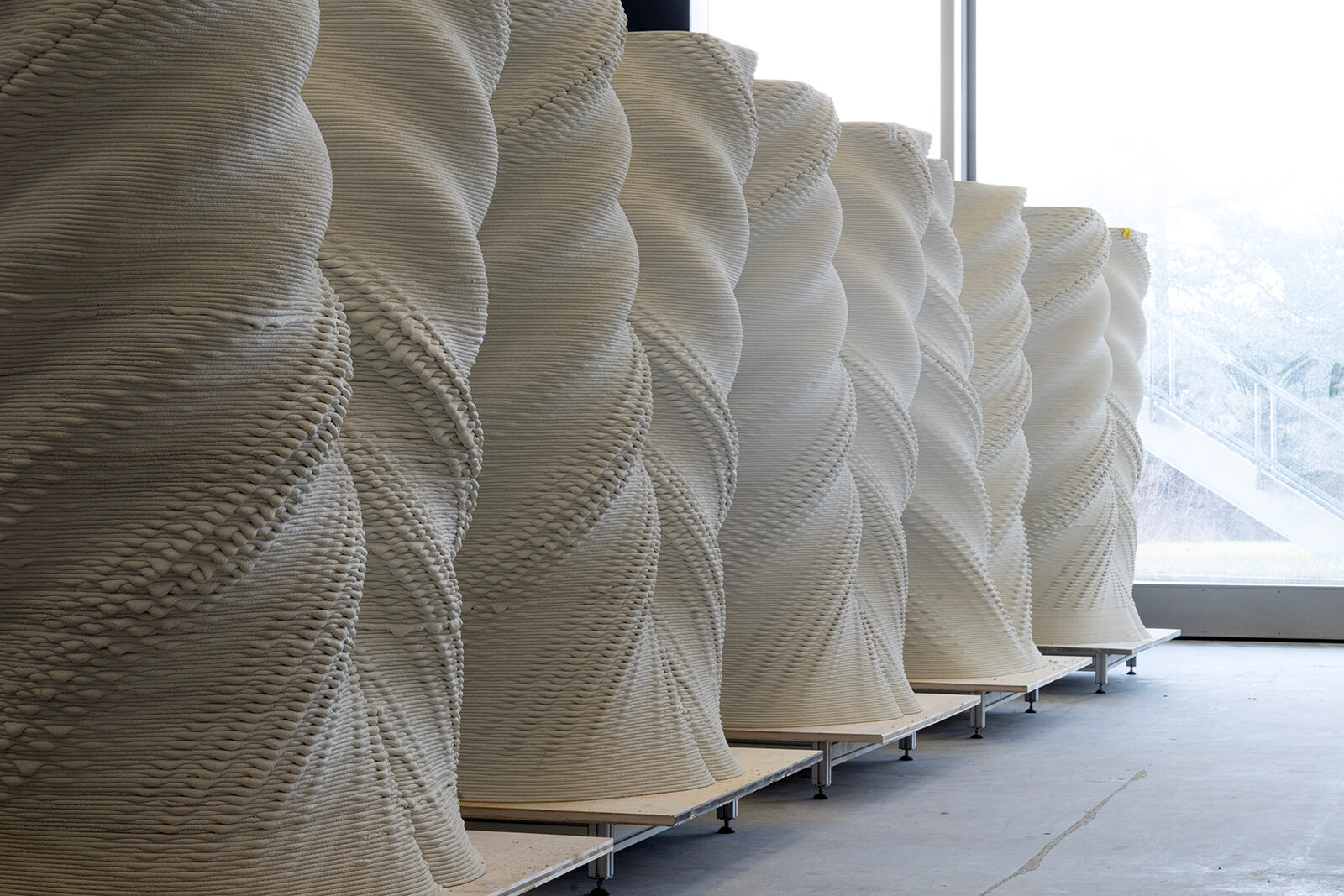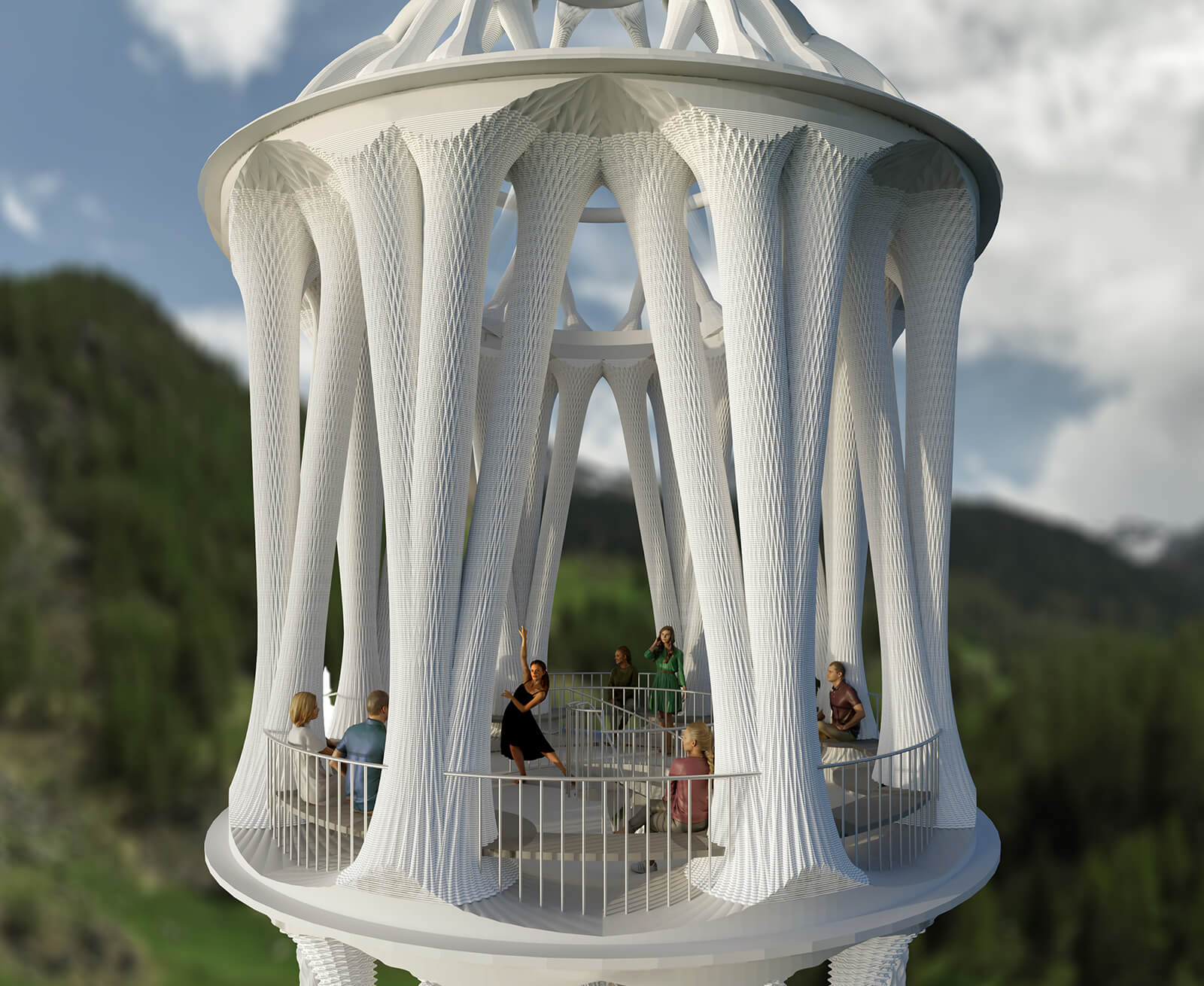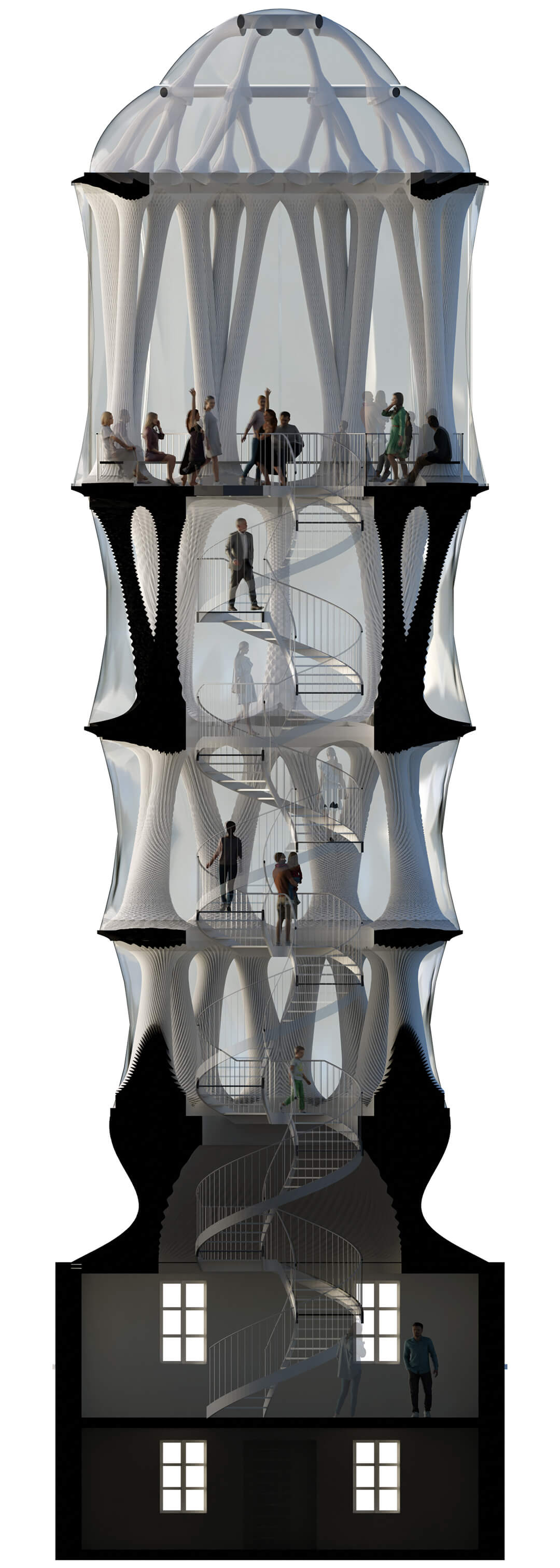Envisioning innovative biomaterials and zero-waste production with OXMAN’s O°
by Anushka SharmaJan 29, 2025
•make your fridays matter with a well-read weekend
by Aarthi MohanPublished on : Mar 23, 2024
In a world where progress often overshadows tradition, a remote village nestled in the Swiss Alps stands as a unique exception. Mulegns, with its timeless allure, serves as a canvas where history seamlessly interacts with innovation. At the forefront of this juxtaposition stands the White Tower, also referred to as Tor Alva by the locals. This towering 30-metre structure, constructed using cutting-edge 3D printing technology along the Julier mountain pass, embodies a harmonious blend of old-world charm and modern design.
Crafted for Fundaziun Origen by architects Benjamin Dillenburger and Michael Hansmeyer in collaboration with The Digital Building Technologies group of ETH Zurich, the tower integrates tradition and contemporary design. More than just a mere architectural highlight, it serves as a vibrant cultural hub, offering spaces for art installations, musical performances, and theatrical productions. Its architecture and innovative technology illustrates the possibilities of computational design and digital fabrication while also providing economic and ecological benefits.
The construction of the tower commenced on Feb 1, 2024, with the fabrication of its columns at ETH Zurich. The first eight columns of the lower floor were meticulously crafted using concrete extrusion. Unlike conventional construction methods, this process eliminates the need for formwork, allowing for greater design freedom and material efficiency. As the robotic extruder carefully deposited layers of concrete, the tower gradually took shape, marking a significant milestone in the advancement of 3D printing technology. This method not only offers design flexibility but also significantly reduces material waste, making it a sustainable design choice for construction.

As the tower emerges, its architectural prowess becomes evident showcasing the diverse capabilities of digital fabrication. Each column, crafted through robotic processes, serves as a canvas for artistic expression, adorned with intricate textures and patterns inspired by the natural beauty of the Alps.
Ascending through the tower’s spiralling corridors, one can embark on a sensory journey through a play of light and shadow, accentuated by the column’s intricate patterns and textures. From the intimate chambers at the base to the vaulted concert venue atop, each level offers a unique spatial experience, punctuated by scenic views of the valley. The tower’s central design element is the 32 branched Y-shaped, 3D-printed columns which enclose a sequence of abstract, atmospheric rooms, reminiscent of the craftsmanship of the master builders of the Baroque era in Grisons. This vertical enfilade culminates into a concert venue, offering an intimate space for events and performances. Each column adorned with a horizontal ornament derived from the concrete printing process, serves as a testament to the tower’s structural ingenuity and aesthetic appeal.
The tower is constructed using an innovative 3D printing process. In this method, a robot applies thin layers of soft concrete through a nozzle, allowing for the creation of homogenous components. This approach enables the printed concrete to be used structurally for the first time, with steel reinforcement seamlessly integrated during the robotic manufacturing process. Embracing the principles of circular economy, the tower is designed for easy dismantling and relocation, reflecting a commitment to sustainability. Its modular design allows for individual components to be effortlessly assembled and disassembled, with elements connected using removable screws rather than adhesives.

Beyond its architectural splendour, the tower serves as a vibrant cultural nexus, offering spaces for art installations, performances, and community gatherings. From intimate concerts to walk-in installations, the tower comes to life with the sounds of music and laughter of community, making it a symbol of unity and celebration. The theatre hall at Tor Alva provides panoramic views of the alpine landscape. With space for 45 guests, it hosts various events under the tower dome and serves as a venue for intimate cultural events and performances. From Rhaeto-Romanic electronic music, author readings and contemporary choreographies, the space offers a platform for artistic expression and community engagement. The roof structure is supported by a central vaulted structure and eight delicate dome supports.
Perched high in the Swiss Alps along the Julier mountain pass, Mulegns has a rich history as a pivotal stagecoach stopover between Switzerland and the Engadin region, fostering connection from Zurich to St. Moritz. Initially modest, the village saw many of its residents leave for opportunities in larger cities, particularly in trades like stucco work and confectionery. However, those who found success abroad often returned to their hometown, contributing to the construction of splendid villas that still grace the village today. As tourism flourished, Mulegns evolved into a vibrant community. By the eve of the First World War, the renowned Post Hotel Löwe epitomised the village’s prosperity, hosting distinguished guests ranging from American presidents to Russian nobility, as well as eminent scientists and Nobel Prize laureates, marking Mulegns as a nexus of international prominence and cultural exchange.
Presently the village is threatened with extinction, with many structures vacant and its population reduced to a mere 16 residents. However, the Nova Fundaziun Origen has embarked on a mission to preserve the village's rich cultural heritage and breathe new life into its historic streets. Notably, the White Villa, now safeguarded by federal protection, was recently rescued in a remarkable relocation effort, while the venerable Post Hotel Löwe has been lovingly restored, welcoming guests once more. Serving as a beacon of hope along the ancient pass road, the White Tower project stands poised to rejuvenate and reinterpret the narrative of this remarkable locale.
As the tower illuminates the night sky with its idiosyncratic openings, it becomes a symbol of resilience and renewal, inspiring residents and visitors alike to reimagine the possibilities of their surroundings.

With its groundbreaking advancements in both design and fabrication, the White Tower stands as a testament to the transformative potential of robotic construction in architecture. As the world's tallest digitally printed building, it embodies the culmination of cutting-edge research, showcasing the market-ready innovations that propel the industry forward. This milestone not just highlights the immense possibilities of 3D printing for construction and architecture but also underscores its environmental benefits, paving the way for safer, more economical, and ecologically sound building practices. By reducing material requirements and CO2 emissions while embracing modularity, circularity, and scalability, the tower sets a new standard for sustainable construction. As we reflect on the achievements of the White Tower, we are compelled to ponder: What other groundbreaking innovations lie on the horizon, waiting to redefine the boundaries of architecture and construction?
Name of project: The White Tower
Location: Mulegns, Switzerland, on the Julier Pass
Structure: Five levels consisting of 32 3D-printed columns. Columns are reinforced and fully structural, 184 3D-printed elements in total
Dimensions: Height: 30.0m, including an existing base, Diameter: 7.0m to 9.0m
Performance space: Capacity: 45 visitors, Total height: 8.0m, covered by dome
3D Printing: 2500 extruded concrete layers, 8mm layer height, 25mm width
Estimated print time: 900 hours
Façade: Removable, lightweight, translucent membrane
Projected opening: Summer 2024
by Anushka Sharma Oct 06, 2025
An exploration of how historic wisdom can enrich contemporary living, the Chinese designer transforms a former Suzhou courtyard into a poetic retreat.
by Bansari Paghdar Sep 25, 2025
Middle East Archive’s photobook Not Here Not There by Charbel AlKhoury features uncanny but surreal visuals of Lebanon amidst instability and political unrest between 2019 and 2021.
by Aarthi Mohan Sep 24, 2025
An exhibition by Ab Rogers at Sir John Soane’s Museum, London, retraced five decades of the celebrated architect’s design tenets that treated buildings as campaigns for change.
by Bansari Paghdar Sep 23, 2025
The hauntingly beautiful Bunker B-S 10 features austere utilitarian interventions that complement its militarily redundant concrete shell.
 surprise me!
surprise me!
make your fridays matter
SUBSCRIBEEnter your details to sign in
Don’t have an account?
Sign upOr you can sign in with
a single account for all
STIR platforms
All your bookmarks will be available across all your devices.
Stay STIRred
Already have an account?
Sign inOr you can sign up with
Tap on things that interests you.
Select the Conversation Category you would like to watch
Please enter your details and click submit.
Enter the 6-digit code sent at
Verification link sent to check your inbox or spam folder to complete sign up process



by Aarthi Mohan | Published on : Mar 23, 2024
What do you think?